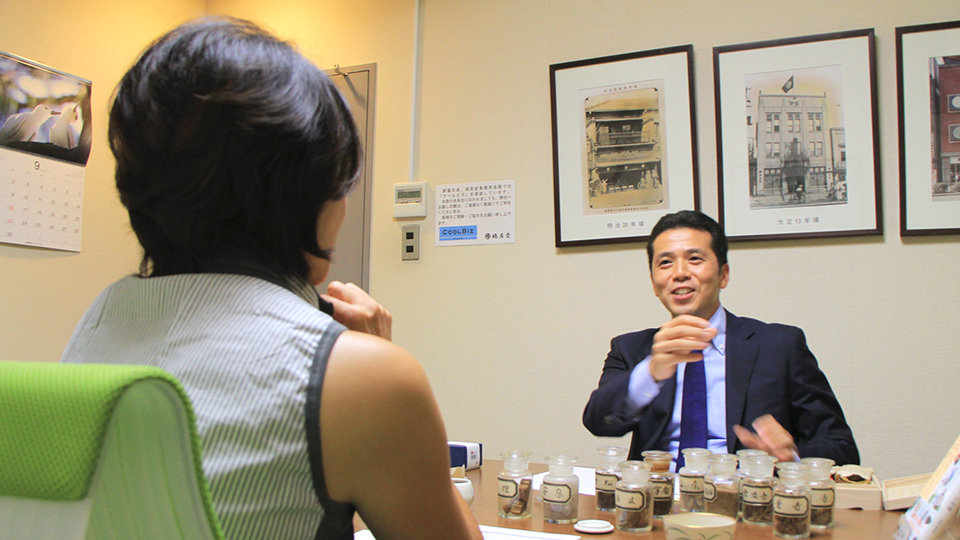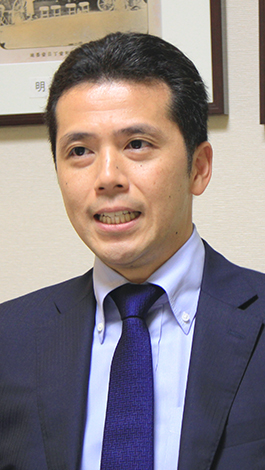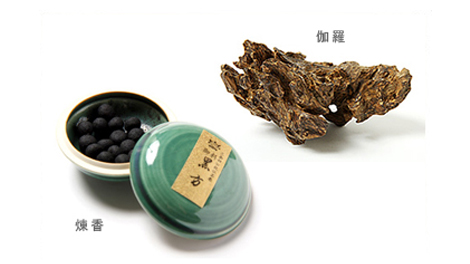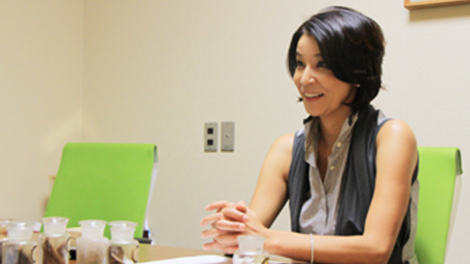
GINZA CONNECTIVE

GINZA CONNECTIVE VOL.25
Michiaki Kumagai×Chisako Takashima
2013.10.04
A talk series with the violinist Chisako Takashima and the Ginza people. Ginza holds many personal and professional memories for Takashima. In this talk series, she thoroughly explores various aspects of the Ginza culture with her guests. Today’s guest is Michiaki Kumagai, the 14th generation president of Kyukyodo, a long-established shop that sells such products as Japanese traditional incense, writing utensils and stationery.
Kyukyodo began as a second-class drug seller in Kyoto
- Takashima
- I shop at Kyukyodo frequently. I am told that when writing a thank you note to someone superior to me, I will be fine as long as I use something from Kyukyodo.
- Kumagai
- Thank you.
- Takashima
- Where does the name Kyukyodo come from?
- Kumagai
- In the Chinese Book of Songs, there is a poem that says, “Where there is a magpie nest, there will be a pigeon.” This refers to how pigeons are poor at making their own nests and plant their eggs in magpie nests instead, like having a rented house. In the same way, our shop is the magpie, and we are the pigeons. The lesson to remember that “We are only looking after the shop that essentially belongs to our customers and the rest of society” is infused in the meaning of the shop’s name.
- Takashima
- That’s quite a lot of humility. I’m sure that’s why your shop has lasted for 350 years. Although I understand that the shop did not sell incense and stationery supplies like it does today, but was actually a second-class drug seller at the beginning. What is that exactly?
- Kumagai
- It’s like a pharmacy. My ancestors became a second-class drug seller in front of the gate of Honnoji temple in Kyoto.
- Takashima
- The shop originated in Kyoto?
- Kumagai
- Yes, my original ancestors are from Kyoto. My grandfather was the second born son, so he branched off.
- Takashima
- I was positive that it originated in Ginza.
So, when did it start selling stationery? - Kumagai
- The ingredients of incense were being imported from China, which after time extended naturally to importing writing brushes and paper.
- Takashima
- I’m really surprised that Kyukyodo, with such a strong image of being a stationery and incense shop, started off as a pharmacy.
- Kumagai
- Actually, Chinese herbal medicine and incense have many ingredients in common. For example, borneol is an essential ingredient of incense.
- Takashima
- (Sniffing the incense) It’s Ryukakusan (a well-known traditional medicine for sore throat)!
- Kumagai
- Yes (laughs). It’s a fragrance that has a cooling sensation. We blend these types of ingredients together to make incense.
- Takashima
- So, incense from long ago is like medicine.


Plant, resin and other natural materials that are the raw ingredients in incense
Kyukyodo continues to preserve incense recipes from the Heian period
- Kumagai
- When they hear “fragrance,” most people these days think of aromatherapy more than incense. So, in addition to incense that we have been selling since long ago, we have also developed aromatherapy-related products.
- Takashima
- Was that your idea?
- Kumagai
- Yes. Aromatherapy is a bit of a deviation from our company image, and there were many pros and cons, but we got creative and developed products like an aroma of sandalwood that is a major fragrance in incense, so that we do not stray too far from our image.
I would be very happy for people to experience the fragrances of incense through aromatherapy. - Takashima
- This may be rude of me to say, but I am the type that doesn’t believe in what I can’t see, and I did not believe in the healing power of fragrances. Nevertheless, I am currently experiencing the second worst period of blues in my life (laughs), and aromatherapy I received from a friend helped me relax, so now I think fragrances may not be such a bad idea.
- Kumagai
- That’s great! Fragrances supposedly work on the more primitive part of your brain and can relax or lift your mood.
- Takashima
- Apparently so. I had never been interested in fragrances up until recently, but now I’ve suddenly started buying things like perfume (laughs). If I like it, I buy it.
- Kumagai
- I hope this leads to an interest in the deep world of Japanese fragrances. For example, this is called ‘neriko’ and is a round pellet of incense made by kneading together a variety of fragrant ingredients. Aristocrats in the Heian era used to make their own original fragrances and infuse their smoke into their kimonos for enjoyment.
- Takashima
- It looks a bit like seirogan (gastrointestinal medicine made of natural ingredients).
- Kumagai
- Someone might think that seeing it for the first time (laughs).
- Takashima
- So, this is the scent of the Heian era… I feel like I’ve been transported back in time (laughs).
- Kumagai
- There once was a man called Sanetomi Sanjo whose family was in charge of preparing incense for the Imperial court. Then, in the early Meiji period, he was named Grand Minister of State and became very busy, so he entrusted his incense duties to Kyukyodo which was highly trusted at court. After that, the incense recipes that had been preserved by the Sanjo family since the Heian era were passed on to Kyukyodo.
- Takashima
- That’s amazing! What is this piece of wood?
- Kumagai
- That’s a fragrant wood called aloes-wood. It’s considered the king of fragrant woods.
- Takashima
- !… Why is this wood so fragrant?
- Kumagai
- It’s unusual, isn’t it? That’s a natural fragrance. It’s a special kind of wood found in Vietnam and other parts of southeast Asia. Is extremely precious, so one gram costs about 20-30,000 yen.
- Takashima
- Wow! That’s a lot. It’s more valuable than gold… Incense is very deep.


1 2
All List
- GINZA CONNECTIVE VOL.0 Ryo Sayegusa×Chisako Takashima
- GINZA CONNECTIVE VOL.1 Toshiyuki Kosaka×Chisako Takashima
- GINZA CONNECTIVE VOL.2 Yasuharu Mizuhara×Chisako Takashima
- GINZA CONNECTIVE VOL.3 Hitoshi Ishihara×Chisako Takashima
- GINZA CONNECTIVE VOL.4 Shinji Hara×Chisako Takashima
- GINZA CONNECTIVE VOL.5 Choichiro Motoyama×Chisako Takashima
- GINZA CONNECTIVE VOL.6 Noriko Okazoe×Chisako Takashima
- GINZA CONNECTIVE VOL.7 Choichiro Motoyama×Chisako Takashima
- GINZA CONNECTIVE VOL.8 Sayuri Yamaguchi×Chisako Takashima
- GINZA CONNECTIVE VOL.9 Yoshiki Tani×Chisako Takashima
- GINZA CONNECTIVE VOL.10 Yoshifumi Itoh×Chisako Takashima
- GINZA CONNECTIVE VOL.11 Kunihiko Miwa×Chisako Takashima
- GINZA CONNECTIVE VOL.12 Shin Watanabe×Chisako Takashima
- GINZA CONNECTIVE VOL.13 Akihiko Tsuda×Chisako Takashima
- GINZA CONNECTIVE VOL.14 Rie Horikawa×Chisako Takashima
- GINZA CONNECTIVE VOL.15 Jun Takahashi×Chisako Takashima
- GINZA CONNECTIVE VOL.16 Yusuke Harada×Chisako Takashima
- GINZA CONNECTIVE VOL.17 Lintaro Mizuhara×Chisako Takashima
- GINZA CONNECTIVE VOL.18 Keisuke Anzai×Chisako Takashima
- GINZA CONNECTIVE VOL.19 Hozu Yamamoto×Chisako Takashima
- GINZA CONNECTIVE VOL.20 Koji Shibata×Chisako Takashima
- GINZA CONNECTIVE VOL.21 Kayo Hosono×Chisako Takashima
- GINZA CONNECTIVE VOL.22 Mitsuru Saito×Chisako Takashima
- GINZA CONNECTIVE VOL.23 Akihisa Kawaguchi×Chisako Takashima
- GINZA CONNECTIVE VOL.24 Mamoru Sugiyama×Chisako Takashima
- GINZA CONNECTIVE VOL.25 Michiaki Kumagai×Chisako Takashima
- GINZA CONNECTIVE VOL.26 Shinichi Tanizawa×Chisako Takashima
- GINZA CONNECTIVE VOL.27 Koichi Suzuki×Chisako Takashima
- GINZA CONNECTIVE VOL.28 Munehito Matsuzaki×Chisako Takashima
- GINZA CONNECTIVE VOL.29 Hiroshi Hara × Chisako Takashima
- GINZA CONNECTIVE VOL.30 Shigeyuki Ando×Chisako Takashima
- GINZA CONNECTIVE VOL.31 Yukichi Ishikura × Chisako Takashima
- GINZA CONNECTIVE VOL.32 Seiko Yamada × Chisako Takashima
- GINZA CONNECTIVE VOL.33 Mami Nagai × Chisako Takashima
- GINZA CONNECTIVE VOL.34 Ryuta Takahashi × Chisako Takashima
- GINZA CONNECTIVE VOL.35 Kazumasa Osumi×Chisako Takashima
- GINZA CONNECTIVE VOL.36 Masahiro Kameoka×Chisako Takashima
- GINZA CONNECTIVE VOL.37 Shoichiro Watanabe×Chisako Takashima
- GINZA CONNECTIVE VOL.38 Keiji Niimoto×Chisako Takashima
- GINZA CONNECTIVE VOL.39 Chieko Nakamura ×Chisako Takashima
- GINZA CONNECTIVE VOL.40 Atsushi Yamane×Chisako Takashima
- GINZA CONNECTIVE VOL.41 Masaya Shibuya×Chisako Takashima
- GINZA CONNECTIVE VOL.42 Makoto Suzuki×Chisako Takashima
- GINZA CONNECTIVE VOL.43 Masaya Konaka×Chisako Takashima
- GINZA CONNECTIVE VOL.44 Masakazu Tanaka×Chisako Takashima
- GINZA CONNECTIVE VOL.45 Koko Kameoka × Chisako Takashima
- GINZA CONNECTIVE VOL.46 Jin Hirayama×Chisako Takashima
- GINZA CONNECTIVE VOL.47 Takashi Hoshihara×Chisako Takashima
- GINZA CONNECTIVE VOL.48 Mikiko Kimura × Chisako Takashima
- GINZA CONNECTIVE VOL.49 Keisuke Okamoto×Chisako Takashima
- GINZA CONNECTIVE VOL.50 Akira Ito × Chisako Takashima
- GINZA CONNECTIVE VOL.51 Tatsuhiko Adachi × Chisako Takashima
- GINZA CONNECTIVE VOL.52 Masahiko Yamano×Chisako Takashima
- GINZA CONNECTIVE VOL.53 Kiyoshi Kanazashi×Chisako Takashima
- GINZA CONNECTIVE VOL.54 Noriyuki Tsuji×Chisako Takashima
- GINZA CONNECTIVE VOL.55 Shoichi Kobayashi×Chisako Takashima
- GINZA CONNECTIVE VOL.56 Isao Nanjo×Chisako Takashima
- GINZA CONNECTIVE VOL.57 Shinobu Mitsuoka×Chisako Takashima
- GINZA CONNECTIVE VOL.58 Motoyoshi Yasuda×Chisako Takashima
- GINZA CONNECTIVE VOL.59 Toru Fujiki×Chisako Takashima
- GINZA CONNECTIVE VOL.60 Yuji Ida×Chisako Takashima
- GINZA CONNECTIVE VOL.61 Hitoshi Miki×Chisako Takashima
- GINZA CONNECTIVE VOL.62 Takehiko Furuya× Chisako Takashima
- GINZA CONNECTIVE VOL.63 Naoki Yoshizawa×Yusuke Yoshizawa×Chisako Takashima
- GINZA CONNECTIVE VOL.64 Kazuhito Kawase × Chisako Takashima
- GINZA CONNECTIVE VOL.65 Toshiji Yuki× Chisako Takashima
- GINZA CONNECTIVE VOL.66 Hikoyuki Yamaguchi×Chisako Takashima
- GINZA CONNECTIVE VOL.67 Daisuke Nagano×Chisako Takashima
- GINZA CONNECTIVE VOL.68 Shuichi Motohashi× Chisako Takashima
- GINZA CONNECTIVE VOL.69 Shinpei Tonaka×Chisako Takashima
- GINZA CONNECTIVE VOL.70 Shinya Kanematsu × Sachiko Takashima
- GINZA CONNECTIVE VOL.71 Masataka Yano×Chisako Takashima
- GINZA CONNECTIVE VOL.72 Mitsuhiro Kurokawa× Chisako Takashima
- GINZA CONNECTIVE VOL.73 Ryo Saegusa×Chisako Takashima








